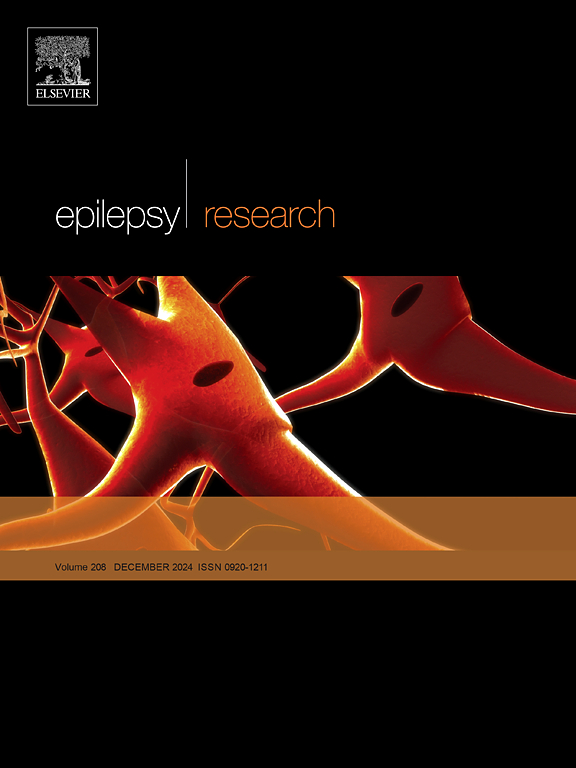Anatomical-electroclinical phenotypes and SEEG-defined network patterns in pure insular lobe epilepsy: A study of 20 cases
IF 2
4区 医学
Q3 CLINICAL NEUROLOGY
引用次数: 0
Abstract
Objective
Insular epilepsy poses significant diagnostic challenges due to its distinctive anatomical location and heterogeneous clinical manifestations. This study aims to develop a comprehensive classification system based on anatomo-electro-clinical features through stereoelectroencephalography (SEEG) analysis. The research seeks to elucidate the specific correspondence between clinical phenotypes and ictal electro-anatomical propagation patterns, investigate the network dynamics underlying various clinical phenotypes, and establish a theoretical framework for the precise diagnosis and personalized treatment of insular epilepsy.
Methods
This single-center retrospective case series included 20 patients with pure insular epilepsy confirmed by stereoelectroencephalography (SEEG) who were treated at Guangdong Sanjiu Brain Hospital between January 2015 and July 2024. The cohort comprised 12 males and 8 females with a mean age of 14.25 ± 9.8 years. All patients underwent individualized SEEG electrode implantation (mean 12.5 ± 2.3 electrodes per patient), comprehensively covering all insular subregions (anterior and posterior insula) and key brain areas in potential propagation pathways. A standardized protocol was employed for systematic analysis of: (1) ictal onset zone localization and electro-anatomical propagation patterns; (2) ictal semiology and clinical phenotype analysis based on video-SEEG recordings; and (3) surgical strategies, pathological findings, and outcome assessment (Engel classification, with follow-up periods ranging from 6 months to 8 years).
Results
The study identified five characteristic clinical phenotypes: the BATS phenotype (35.0 %), tonic-hypermotor phenotype (25.0 %), hypermotor-autonomic phenotype (25.0 %), pure sensory phenotype (10.0 %), and pure autonomic phenotype (5.0 %). These phenotypes demonstrated specific correspondence with six distinct SEEG propagation patterns. Posterior insular epilepsy (70.0 %) preferentially propagated through sensorimotor networks, whereas anterior insular epilepsy (30.0 %) primarily spread via limbic system networks. Focal cortical dysplasia was the predominant pathological finding (94.7 %). All surgical patients (n = 19) achieved Engel Ia outcome, with follow-up periods ranging from 6 months to 8 years.
Conclusion
This study established an anatomo-electro-clinical classification system for insular epilepsy and elucidated the specific correspondence between clinical phenotypes and neuronal network propagation patterns. This correspondence reflects the characteristic propagation of epileptic activity through pre-existing functional connectivity networks, providing a theoretical foundation for the precise diagnosis and personalized treatment of insular epilepsy.
纯岛叶癫痫的解剖-电临床表型和seeg定义的网络模式:20例的研究
目的岛状癫痫由于其独特的解剖位置和异质性的临床表现,给诊断带来了巨大的挑战。本研究旨在通过立体脑电图(SEEG)分析,建立一个基于解剖-电-临床特征的综合分类系统。本研究旨在阐明临床表型与颅电解剖传播模式之间的特定对应关系,探讨各种临床表型背后的网络动力学,为岛状癫痫的精确诊断和个性化治疗建立理论框架。方法选取2015年1月至2024年7月在广东省三九脑科医院经立体脑电图(SEEG)确诊的单纯岛状癫痫患者20例为单中心回顾性病例。该队列包括12名男性和8名女性,平均年龄为14.25 ± 9.8岁。所有患者均行个体化SEEG电极植入(平均12.5 ± 2.3个电极/例),全面覆盖所有岛叶亚区(岛叶前叶和岛叶后叶)和脑电位传播通路的关键区域。采用标准化方案进行系统分析:(1)起病区定位和电解剖传播模式;(2)基于视频seeg记录的体征符号学和临床表型分析;(3)手术策略、病理结果和预后评估(Engel分类,随访时间从6个月到8年)。结果鉴定出5种特征性临床表型:BATS表型(35.0 %)、强直-过度运动表型(25.0 %)、过度运动-自主表型(25.0 %)、纯感觉表型(10.0 %)和纯自主表型(5.0 %)。这些表型与六种不同的SEEG繁殖模式有特定的对应关系。后岛癫痫(70.0 %)优先通过感觉运动网络传播,而前岛癫痫(30.0 %)主要通过边缘系统网络传播。局灶性皮质发育不良是主要的病理表现(94.7 %)。所有手术患者(n = 19)均达到Engel Ia结局,随访时间为6个月至8年。结论本研究建立了岛岛癫痫的解剖-电-临床分类体系,阐明了岛岛癫痫的临床表型与神经元网络传播模式之间的特定对应关系。这种对应关系反映了癫痫活动通过预先存在的功能连接网络进行特征性传播,为岛状癫痫的精确诊断和个性化治疗提供了理论基础。
本文章由计算机程序翻译,如有差异,请以英文原文为准。
求助全文
约1分钟内获得全文
求助全文
来源期刊

Epilepsy Research
医学-临床神经学
CiteScore
0.10
自引率
4.50%
发文量
143
审稿时长
62 days
期刊介绍:
Epilepsy Research provides for publication of high quality articles in both basic and clinical epilepsy research, with a special emphasis on translational research that ultimately relates to epilepsy as a human condition. The journal is intended to provide a forum for reporting the best and most rigorous epilepsy research from all disciplines ranging from biophysics and molecular biology to epidemiological and psychosocial research. As such the journal will publish original papers relevant to epilepsy from any scientific discipline and also studies of a multidisciplinary nature. Clinical and experimental research papers adopting fresh conceptual approaches to the study of epilepsy and its treatment are encouraged. The overriding criteria for publication are novelty, significant clinical or experimental relevance, and interest to a multidisciplinary audience in the broad arena of epilepsy. Review articles focused on any topic of epilepsy research will also be considered, but only if they present an exceptionally clear synthesis of current knowledge and future directions of a research area, based on a critical assessment of the available data or on hypotheses that are likely to stimulate more critical thinking and further advances in an area of epilepsy research.
 求助内容:
求助内容: 应助结果提醒方式:
应助结果提醒方式:


